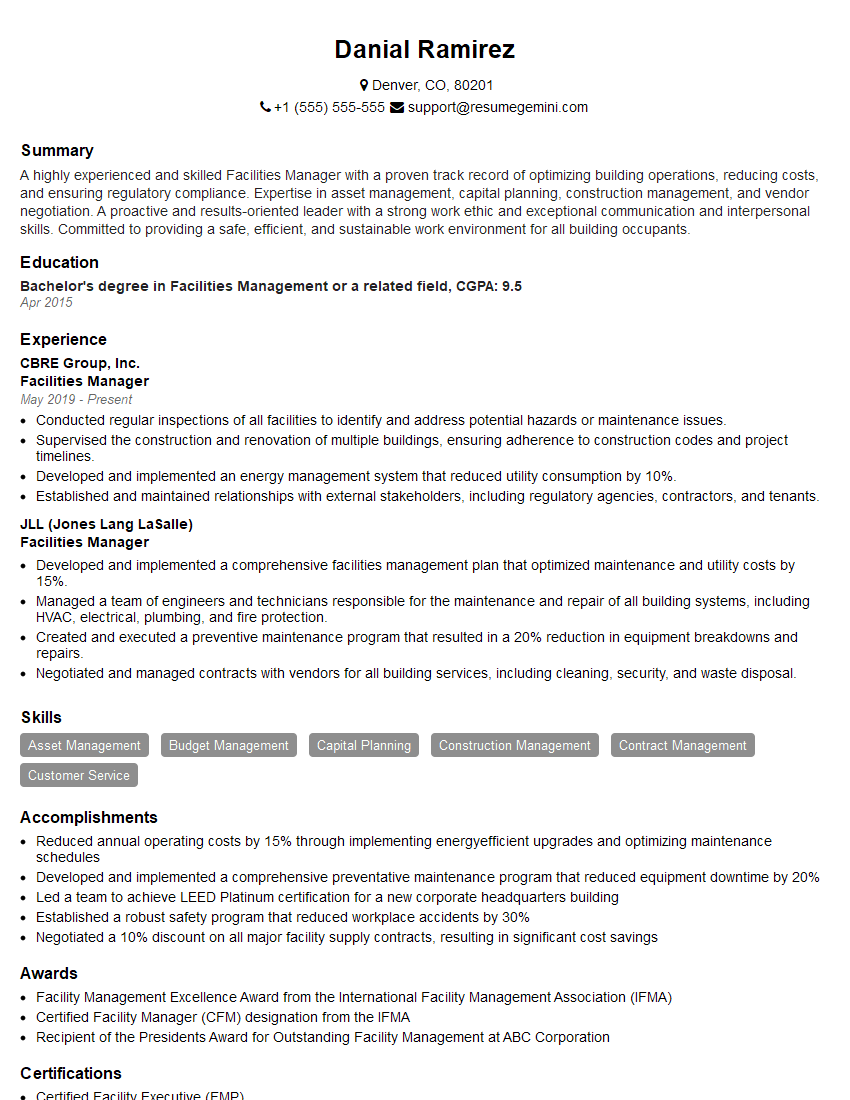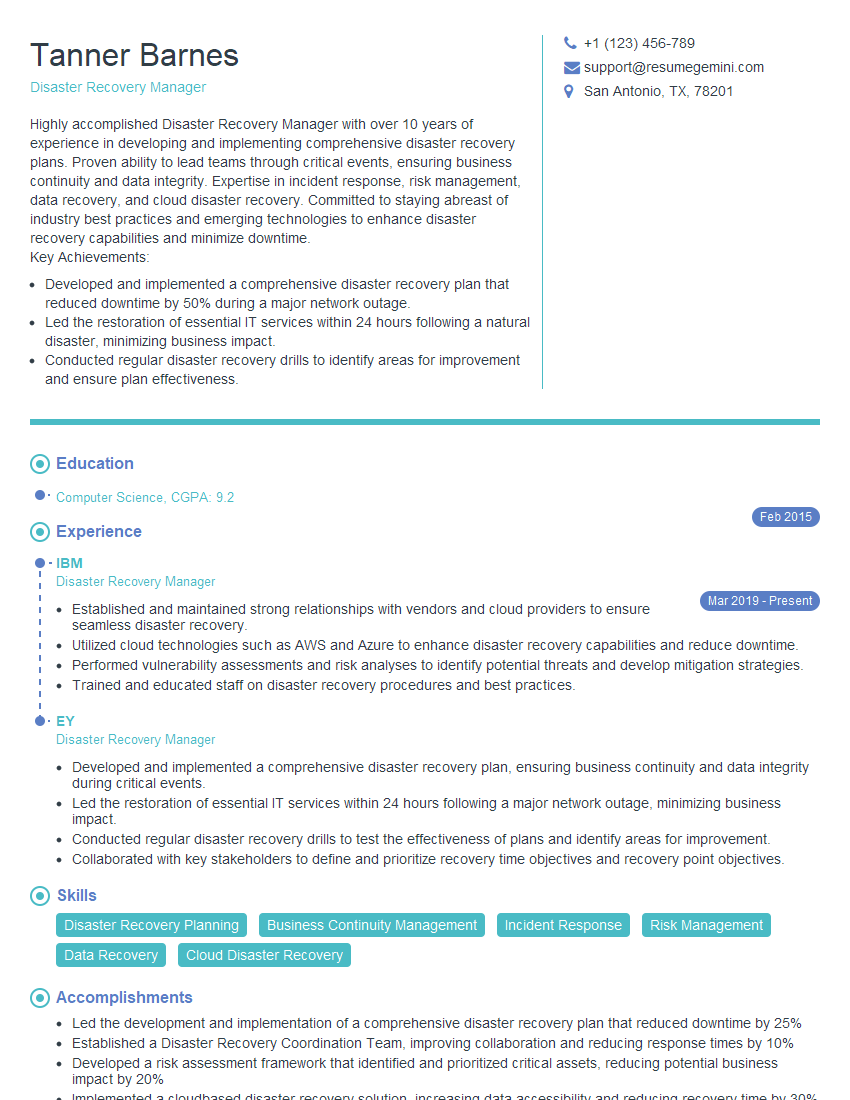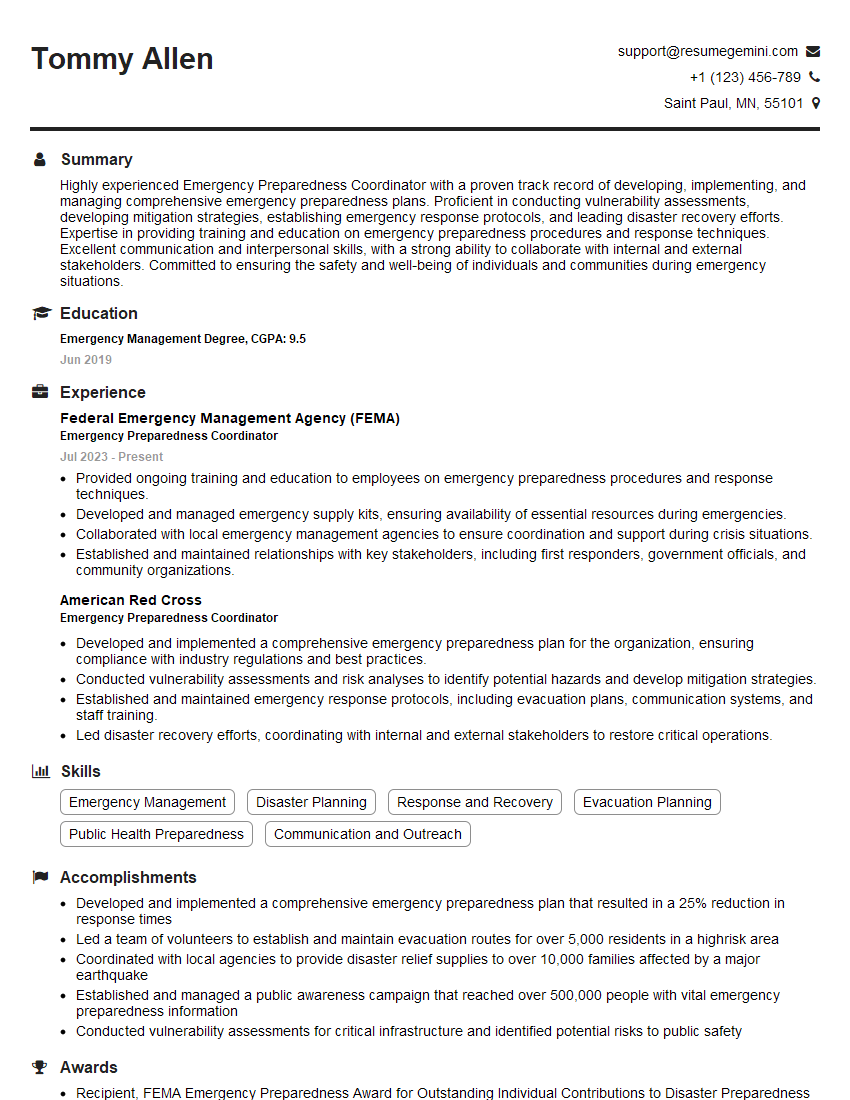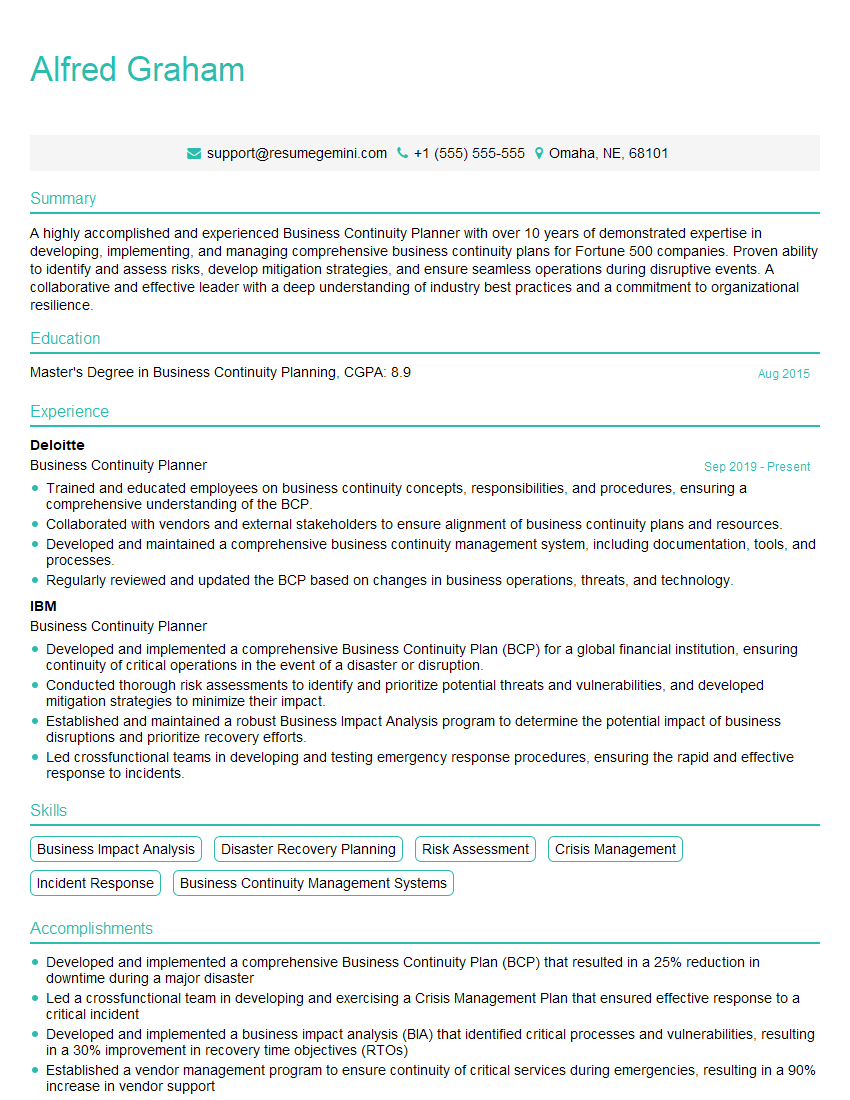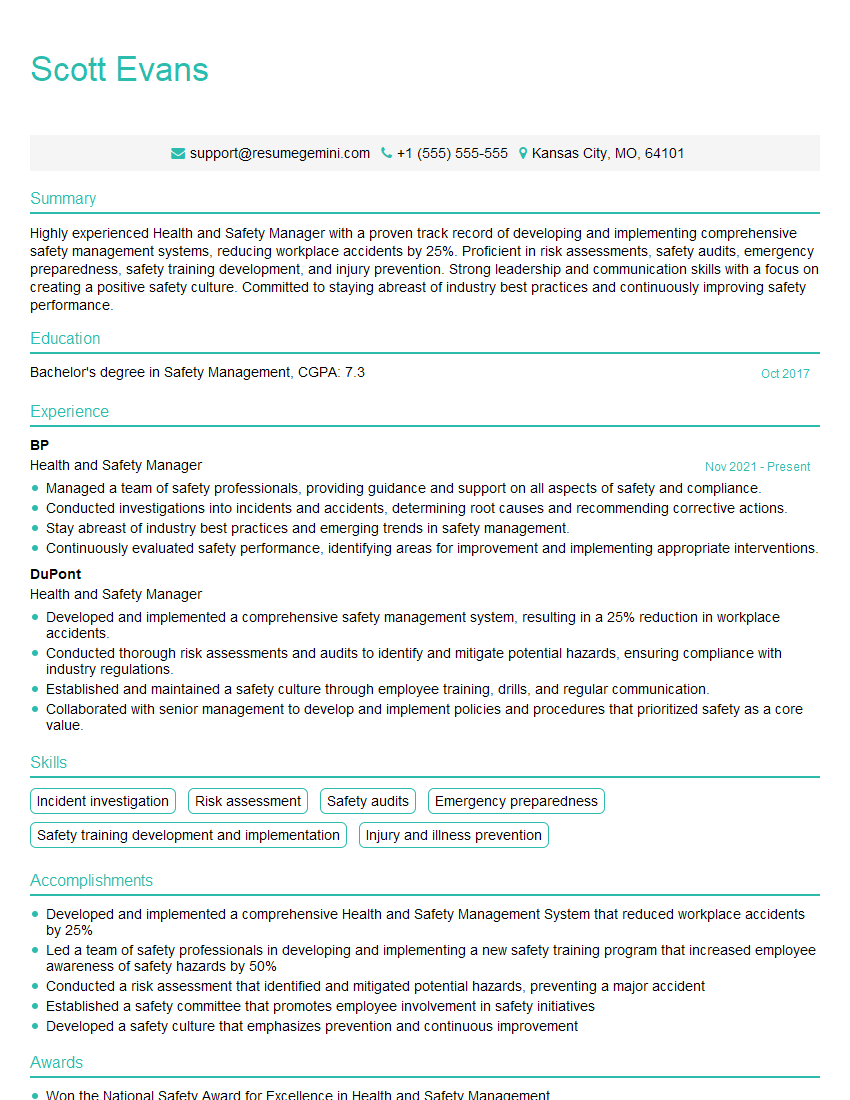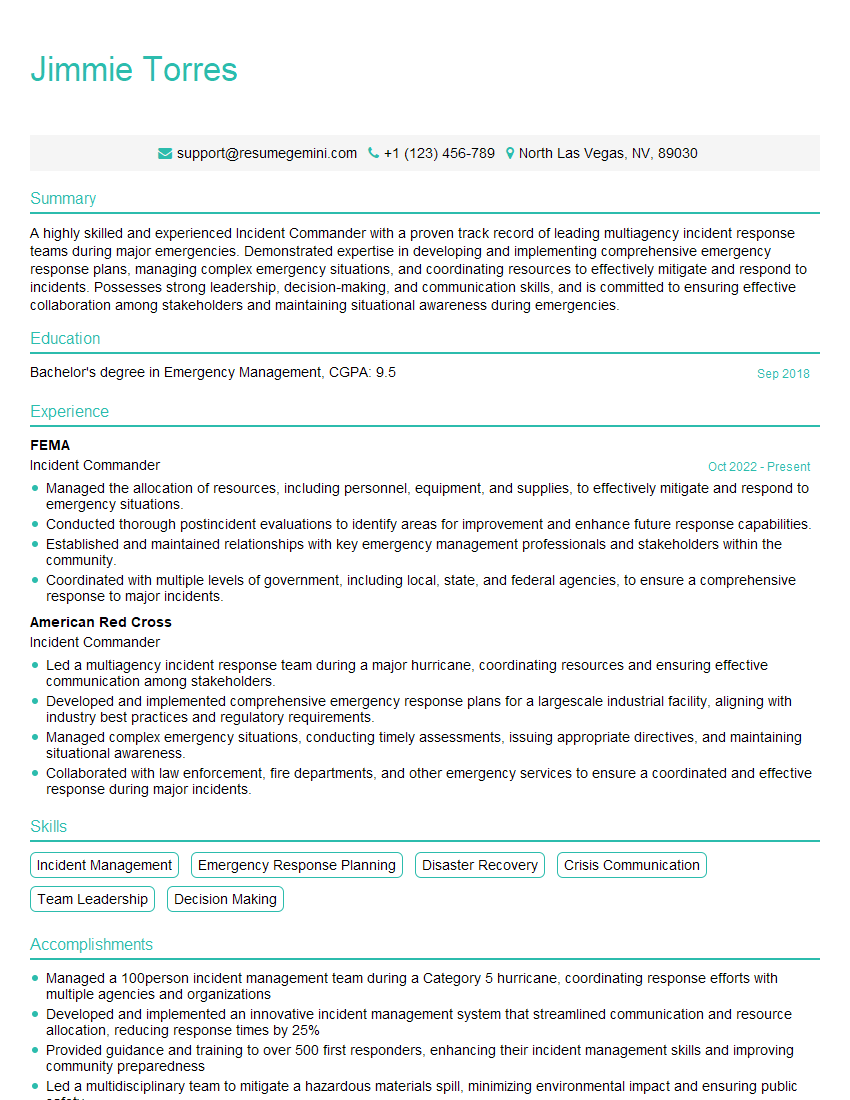Are you ready to stand out in your next interview? Understanding and preparing for Evacuation Management interview questions is a game-changer. In this blog, we’ve compiled key questions and expert advice to help you showcase your skills with confidence and precision. Let’s get started on your journey to acing the interview.
Questions Asked in Evacuation Management Interview
Q 1. Describe your experience developing and implementing evacuation plans.
Developing and implementing evacuation plans is a multifaceted process requiring careful consideration of numerous factors. It begins with a thorough understanding of the building’s layout, occupancy, potential hazards, and the specific needs of its occupants. My approach involves a five-step process: 1. Risk Assessment: Identifying all potential hazards and vulnerabilities. 2. Route Planning: Designing clear, safe, and accessible evacuation routes, considering factors like width, signage, and potential obstacles. 3. Communication Strategy: Developing a robust communication plan to ensure timely and effective information dissemination. This includes the use of various tools, from audible alarms to designated communication personnel and digital platforms. 4. Training and Drills: Conducting regular drills to familiarize occupants with the plan and identify areas for improvement. 5. Documentation and Review: Maintaining comprehensive documentation of the plan and conducting regular reviews to ensure its effectiveness and update it as needed. For example, in a recent project for a large office building, I worked closely with the building management to develop a plan that incorporated color-coded signage, multiple exit points, and designated assembly points for efficient headcount. This plan included specific procedures for assisting people with disabilities, which were rigorously tested during multiple drills.
Q 2. How would you conduct a risk assessment for an evacuation plan?
A thorough risk assessment is paramount to a successful evacuation plan. It involves systematically identifying all potential hazards that could impede an evacuation, such as fire, earthquakes, floods, or active shooter situations. I utilize a structured approach that includes: 1. Hazard Identification: Brainstorming sessions with stakeholders, reviewing building plans, and examining past incident reports to identify potential hazards. 2. Vulnerability Analysis: Evaluating the building’s structural integrity, the accessibility of evacuation routes, and the potential impact of hazards on different population groups. 3. Risk Evaluation: Assessing the likelihood and severity of each identified hazard. This often involves using qualitative or quantitative methods to determine the potential impact of various scenarios. 4. Mitigation Strategies: Developing and prioritizing strategies to reduce or eliminate identified risks. This may involve installing fire suppression systems, improving signage, or providing specialized training for staff. For instance, in assessing a school, I’d specifically analyze the potential delays caused by the age and mobility of students, factoring this into route planning and staff responsibilities.
Q 3. What are the key elements of a successful evacuation drill?
A successful evacuation drill is more than just a practice run; it’s a crucial tool for identifying weaknesses and refining the plan. Key elements include: 1. Realistic Scenario: Simulating a realistic emergency, such as a fire or bomb threat, to test the plan’s effectiveness under pressure. 2. Clear Communication: Utilizing the designated communication systems to ensure everyone receives instructions promptly and accurately. 3. Timed Exercise: Recording the time taken for the complete evacuation to identify bottlenecks and areas needing improvement. 4. Debriefing Session: Conducting a thorough post-drill analysis to identify areas for improvement in the plan, communication, and response times. 5. Documentation: Maintaining comprehensive records of the drill, including observations, challenges faced, and improvement plans. For example, a recent drill at a hospital showed that wheelchair access to a secondary stairwell was significantly slower than anticipated. This feedback was used to modify the plan and improve staff training for assisting patients with mobility issues.
Q 4. Explain your understanding of different evacuation routes and procedures.
Evacuation routes and procedures must be tailored to the specific building and its potential hazards. Different routes are designed to handle varying situations. For example, primary routes are the main escape paths, often clearly marked and wide enough for swift evacuation. Secondary routes provide alternative exits, often used if primary routes are blocked. Procedures involve specific instructions on how to move through each route safely and efficiently. These procedures should account for the following: 1. Assembly Points: Designated locations where evacuees gather for headcount and further instructions. 2. Evacuation Leaders: Designated individuals responsible for guiding and assisting occupants during evacuation. 3. Emergency Exits: Clearly marked and easily accessible exits. 4. Procedures for People with Disabilities: Plans for assisting individuals with disabilities, including those with mobility issues, visual impairments, or other special needs. For instance, a high-rise building might require different procedures for occupants on lower versus upper floors, factoring in stairwell capacity and potential for smoke accumulation.
Q 5. How do you ensure compliance with relevant safety regulations during evacuations?
Ensuring compliance with safety regulations is crucial. This requires a thorough understanding of relevant codes and standards, such as the International Building Code (IBC), NFPA standards, and OSHA guidelines. My approach involves: 1. Regular Inspections: Conducting regular inspections of the building and evacuation routes to ensure compliance with all applicable regulations. 2. Documentation: Maintaining comprehensive documentation of all inspections, training, and drills. 3. Training: Providing regular training for building staff and occupants on emergency procedures and safety regulations. 4. Collaboration with Authorities: Working closely with fire marshals, building inspectors, and other regulatory bodies to ensure compliance and address any issues promptly. For instance, I ensure that all emergency signage complies with the latest ANSI standards and that emergency lighting is adequately maintained, regularly testing its functionality.
Q 6. What communication systems do you utilize during an evacuation?
Effective communication is the backbone of any successful evacuation. I leverage a multi-layered communication strategy that includes: 1. Audible Alarms: Using horns, bells, or other audible warning devices to alert occupants of an emergency. 2. Visual Signals: Employing flashing lights, illuminated exit signs, or other visual signals to guide occupants to safety. 3. Public Address Systems (PA): Using PA systems to provide clear and concise instructions during an evacuation. 4. Two-Way Radios: Utilizing two-way radios for real-time communication between evacuation leaders and emergency responders. 5. Text and Email Alerts: Utilizing text and email alerts for pre-emptive or supplementary messaging to occupants. The selection of these systems depends on the building’s size, complexity, and the specific needs of its occupants. For example, a hospital would need a more sophisticated system that prioritizes communication with staff and specific patient needs.
Q 7. How do you account for individuals with disabilities during an evacuation?
Accommodating individuals with disabilities is a critical aspect of evacuation planning. This requires a proactive and inclusive approach that ensures everyone can safely evacuate. Strategies I utilize include: 1. Accessibility Audits: Conducting thorough accessibility audits to identify barriers and develop solutions. 2. Designated Assistants: Training designated personnel to assist individuals with disabilities during an evacuation. 3. Accessible Routes: Ensuring that evacuation routes are accessible to individuals using wheelchairs, mobility aids, or other assistive devices. 4. Communication Strategies: Using multiple communication methods to reach people with various disabilities, such as visual or auditory impairments. 5. Pre-Planned Assistance: Developing pre-planned assistance strategies for individuals who require specific support during evacuation, such as those with cognitive impairments or medical conditions. For example, in a school setting, we’d work with teachers to identify students with special needs and develop individualized evacuation plans for them, ensuring their safety through specific escort routes and assistance methods.
Q 8. How would you handle a situation where an evacuation is delayed or disrupted?
Evacuation delays or disruptions are serious incidents that require immediate, adaptable responses. My approach involves a layered strategy: first, assessing the cause of the delay – is it a blocked exit, a sudden change in the emergency situation, or a breakdown in communication? Once the cause is identified, I implement contingency plans. These might involve rerouting evacuees to alternative exits, establishing temporary safe zones, or deploying additional personnel to assist with crowd control and communication.
For example, during a fire evacuation, if the primary staircase becomes inaccessible due to smoke, pre-planned alternative routes, communicated during training, are immediately activated. Simultaneously, communication channels are utilized to provide updates to evacuees and emergency services, calming anxieties and managing expectations. If the disruption involves a critical infrastructure failure, I would liaise with emergency services to secure additional resources like generators or emergency lighting. Regularly reviewing and updating evacuation plans to incorporate these ‘what-if’ scenarios is crucial. This ensures we’re prepared for unexpected challenges and have readily available solutions.
Q 9. What are the key performance indicators (KPIs) you use to measure the effectiveness of an evacuation plan?
Key Performance Indicators (KPIs) for evaluating evacuation plan effectiveness are multifaceted and must measure both preparedness and response. I focus on these key areas:
- Evacuation Time: The total time taken for complete evacuation. A shorter time demonstrates efficiency.
- Compliance Rate: The percentage of personnel who followed the designated evacuation routes and procedures. High compliance indicates effective training and communication.
- Casualty Rate: The number of injuries or fatalities during the evacuation. Zero casualties is the ultimate goal.
- Resource Utilization: How effectively were resources like emergency exits, communication systems, and personnel deployed? Efficient use points to strong planning and execution.
- Post-Evacuation Survey Feedback: Gathering feedback from personnel on their experiences identifies areas needing improvement in the plan or training.
These KPIs, tracked consistently across multiple drills and real events, provide data-driven insights to refine the plan and ensure continual improvement.
Q 10. Describe your experience in coordinating with emergency services during evacuations.
Coordination with emergency services is paramount. My experience involves establishing clear communication protocols before, during, and after an evacuation. This begins with pre-event briefings to familiarize emergency responders with the facility layout, potential hazards, and designated assembly points. During an evacuation, I maintain constant contact with the incident commander, providing real-time updates on the number of people evacuated, any challenges encountered, and the location of any injured individuals. Post-event, we conduct debriefings to analyze the response and identify areas for improvement in our collaborative efforts. For instance, in a recent large-scale evacuation, we used a dedicated communication channel, allowing seamless information sharing with fire departments and paramedics, ensuring a rapid and organized rescue.
Q 11. How do you conduct post-evacuation reviews and identify areas for improvement?
Post-evacuation reviews are crucial for continuous improvement. My process involves a structured approach using a combination of methods:
- Data Analysis: Analyzing KPIs (as described above) to identify bottlenecks and areas requiring improvement.
- Debriefing Sessions: Conducting formal meetings with personnel involved in the evacuation to gather feedback, discuss challenges, and highlight successful strategies.
- Incident Reports: Compiling comprehensive reports documenting the event timeline, challenges, and lessons learned.
- Simulation Exercises: Conducting tabletop exercises or full-scale drills to test revised procedures and identify weaknesses before the next real event.
For example, after a recent drill, we identified that signage at a particular corridor was insufficient, leading to some confusion. This feedback was immediately incorporated by improving the signage and conducting further training on the updated route.
Q 12. How familiar are you with different types of emergency notification systems?
I’m familiar with a range of emergency notification systems, including:
- Public Address Systems (PA): Ideal for immediate, site-wide announcements within a building.
- Text Messaging (SMS): Effective for reaching individuals even when phone lines are congested. We use this as an immediate alert and for follow-up instructions.
- Email Alerts: Used for less urgent notifications or providing detailed updates.
- Mobile Apps: Dedicated mobile apps provide real-time updates and mapping of evacuation routes. This is particularly useful for larger facilities.
- Outdoor Warning Systems (OWS): Such as sirens, used for large-scale, geographically dispersed warnings.
The choice of system depends on the specific context – a small office might rely on PA and email, while a large campus might utilize a combination of all the above, integrating them for redundancy and maximized reach.
Q 13. What strategies do you employ to ensure the safety of personnel during an evacuation?
Ensuring personnel safety during evacuation relies on a multi-pronged approach:
- Clear and Concise Communication: Using multiple notification systems to ensure everyone receives the alert and understands the instructions.
- Designated Assembly Points: Establishing clear assembly points allows for a headcount and ensures no one is left behind.
- Trained Personnel: Having trained personnel to assist with crowd control, first aid, and guiding individuals with disabilities.
- Emergency Equipment: Providing adequate lighting, first-aid kits, and other essential equipment at assembly points.
- Accessibility Considerations: Planning evacuation routes that accommodate individuals with disabilities, including providing alternative exits and assistance where needed.
Regular drills and simulations ensure that these strategies are practiced and refined, leading to a smoother and safer evacuation process.
Q 14. Describe your process for training employees on evacuation procedures.
Employee training on evacuation procedures is a continuous process. My approach includes:
- Initial Training: All new employees receive comprehensive training on evacuation routes, procedures, and assembly points, including the use of emergency equipment.
- Regular Drills: Conducting both unannounced and announced drills to ensure that procedures are ingrained and any issues can be identified.
- Refresher Training: Providing periodic refresher training to reinforce knowledge and address changes in procedures or facility layout.
- Scenario-Based Training: Using realistic scenarios during drills to prepare employees for various situations.
- Feedback and Evaluation: Gathering feedback from employees after drills and using this to improve the training program.
This systematic training helps to instill confidence, improve response times, and ensure a coordinated and safe evacuation for all employees.
Q 15. How do you handle resistance or non-compliance from employees during an evacuation?
Resistance during evacuations stems from various factors: fear, disbelief, panic, or simply a lack of understanding. My approach is multifaceted, prioritizing clear communication and training. Firstly, I ensure all employees receive comprehensive evacuation drills and training, emphasizing the importance of immediate compliance. This includes clear instructions on procedures, designated assembly points, and the consequences of non-compliance. Secondly, I foster a culture of safety through regular communication, emphasizing the seriousness of emergency situations and the role each employee plays in ensuring everyone’s safety. During an actual evacuation, I would employ calm, assertive communication, clearly explaining the urgency and directing individuals firmly but respectfully. In situations involving stubborn resistance, I would involve security personnel or designated emergency responders to assist, ensuring the safety and well-being of all while maintaining a respectful approach. For instance, in one situation, an employee initially refused to leave their workstation due to ongoing work. A calm explanation of the potential danger and the need for immediate evacuation, coupled with support from a supervisor to secure their work, quickly resolved the issue.
Career Expert Tips:
- Ace those interviews! Prepare effectively by reviewing the Top 50 Most Common Interview Questions on ResumeGemini.
- Navigate your job search with confidence! Explore a wide range of Career Tips on ResumeGemini. Learn about common challenges and recommendations to overcome them.
- Craft the perfect resume! Master the Art of Resume Writing with ResumeGemini’s guide. Showcase your unique qualifications and achievements effectively.
- Don’t miss out on holiday savings! Build your dream resume with ResumeGemini’s ATS optimized templates.
Q 16. How do you assess the adequacy of existing emergency exits and escape routes?
Assessing the adequacy of emergency exits and escape routes requires a systematic approach. I begin with a thorough review of building plans and codes, checking for compliance with local regulations. This includes verifying the number and size of exits, the width and accessibility of escape routes, the presence of signage, and the functionality of emergency lighting. I then conduct a physical inspection of the building, walking through all escape routes, noting any potential obstructions, bottlenecks, or safety hazards. This involves checking for adequate spacing, clear signage, accessible exits for people with disabilities, and the absence of obstacles. I would also assess the capacity of the exits to handle the expected number of occupants during peak times, and the accessibility of the assembly points. Any deficiencies identified are documented and prioritized for remediation, potentially involving consultations with fire marshals or building safety professionals. For instance, identifying a narrow corridor as a bottleneck requires implementing strategies like improved signage to direct flow or redesigning the area to improve capacity.
Q 17. How would you manage an evacuation in a large, complex building?
Managing an evacuation in a large, complex building demands meticulous planning and coordination. My strategy involves a hierarchical command structure, with designated floor wardens, zone leaders, and overall evacuation coordinators. Each floor warden is responsible for ensuring the safe evacuation of their assigned area. Zone leaders oversee multiple floors, coordinating efforts and reporting to the overall coordinator. Pre-assigned assembly points and designated communication channels are crucial. Clear, consistent signage and well-rehearsed drills are also essential. Before the evacuation, we’d utilize building management systems or dedicated software to understand occupancy levels in real-time. During the evacuation, we would utilize two-way radios or other communication tools for swift updates and coordination. For complex scenarios, we’d deploy floor plans with marked routes and real-time monitoring of evacuation progress through CCTV or sensor technology. Regular post-incident reviews and simulations enable continuous improvement. For example, a large office complex evacuation might require zoning the building into smaller areas, assigning floor wardens to each zone with clear instructions and designated assembly points for each zone.
Q 18. Explain your experience with crowd management during evacuations.
Crowd management during evacuations is paramount. My experience highlights the importance of clear communication, designated routes, and trained personnel. I focus on techniques like managing crowd flow through designated pathways, preventing bottlenecks, and using visual cues and announcements to guide people to safety. Having trained marshals at key points helps to prevent panic and ensure orderly movement. Utilizing crowd simulation software helps to identify potential bottlenecks and optimize evacuation routes. In one instance, a well-rehearsed drill with clearly marked routes and designated marshals enabled the swift and safe evacuation of a large shopping mall during a fire, minimizing panic and injuries. The marshals effectively guided people, addressing individual concerns and anxieties, keeping the movement orderly.
Q 19. What are some common challenges you’ve faced during evacuations?
Common challenges in evacuations include unexpected obstacles (e.g., equipment malfunction, blocked exits), communication breakdowns, inadequate training, and panic. For instance, a power outage during an evacuation can lead to significant challenges in lighting and communication. Inadequate staff training can lead to confusion and delays, hindering evacuation efficiency. Another challenge is managing the needs of diverse populations, like those with disabilities or language barriers. Overcoming these involves comprehensive risk assessments, robust communication plans, and inclusive training programs. Regular drills and simulations under varying conditions help in identifying and addressing potential issues proactively.
Q 20. How do you adapt evacuation plans to different scenarios (e.g., fire, natural disaster)?
Evacuation plans must be adaptable to different scenarios. A fire evacuation emphasizes speed and a direct route to the nearest safe exit. A natural disaster, such as an earthquake, might necessitate sheltering in place initially before a controlled evacuation. A bomb threat involves specific protocols such as a slow, orderly evacuation, avoiding triggering potential devices. Adaptability involves creating modular plans with customizable elements. Emergency response training should incorporate various scenarios, and the plan should clearly define actions for each potential event, including designated assembly points that may differ based on the nature of the emergency. For instance, a fire evacuation plan might include specific instructions for individuals in high-rise buildings, whereas a flood evacuation plan would prioritize safe transport to higher ground.
Q 21. What software or tools do you use to support evacuation management?
Several software and tools support evacuation management. Computer-aided design (CAD) software allows for detailed building modeling, identifying potential bottlenecks and improving route planning. Crowd simulation software helps visualize crowd movements under different scenarios, optimizing evacuation strategies. Building management systems (BMS) provide real-time data on occupancy, enabling informed decision-making during emergencies. Communication platforms, such as two-way radios or dedicated apps, facilitate effective coordination between personnel. Data analytics platforms can be utilized to gather data from past evacuations, identify trends, and improve future planning. For example, a software like Pathfinder can model building layouts and simulate evacuations, highlighting areas prone to congestion, enabling the identification and correction of design flaws or procedural improvements.
Q 22. How do you maintain and update evacuation plans regularly?
Maintaining and updating evacuation plans is a crucial ongoing process, not a one-time task. Think of it like regularly servicing a complex machine – you need consistent attention to ensure it functions effectively in an emergency. We use a structured approach, incorporating several key elements:
- Regular Reviews (at least annually): We conduct thorough reviews of the plans, examining changes in building layout, occupancy, emergency response procedures, and any lessons learned from drills or actual incidents. This helps identify outdated information or newly introduced risks.
- Post-Incident Analysis: After any evacuation, whether a drill or real event, we perform a detailed analysis. This includes reviewing communication effectiveness, identifying bottlenecks, and assessing the overall response. These findings directly inform updates to the evacuation plans.
- Technological Updates: We incorporate new technologies, such as updated communication systems or emergency notification apps, to enhance the efficiency and reach of the evacuation process. This might include integrating with building management systems for automated alerts or using GPS tracking for personnel accountability.
- Stakeholder Input: We actively seek input from building occupants, emergency responders, and other stakeholders. Their perspectives provide valuable insights and ensure the plan reflects the practical needs and concerns of everyone involved. Regular meetings and feedback mechanisms are vital.
- Documentation and Version Control: All changes to the evacuation plan are meticulously documented and tracked. We use version control to maintain a clear history of modifications and ensure everyone works from the most current version.
For example, a recent renovation to a hospital wing required a complete revision of the evacuation routes for that area. Our post-incident analysis from a recent fire drill highlighted the need for improved signage in a particular corridor, leading to immediate changes in the plan and signage implementation.
Q 23. Explain your understanding of legal and regulatory requirements related to evacuations.
Legal and regulatory requirements surrounding evacuations are stringent and vary depending on location and building type. These regulations are designed to protect human life and ensure a safe and orderly evacuation process. Understanding and complying with these requirements is non-negotiable.
- Building Codes and Fire Safety Regulations: These codes dictate minimum requirements for building design, fire suppression systems, emergency exits, and signage. Evacuation plans must adhere to these standards, ensuring sufficient egress capacity and clear escape routes.
- Occupational Safety and Health Administration (OSHA) Regulations: OSHA standards cover workplace safety, including emergency action plans. These regulations mandate procedures for emergency evacuation, employee training, and emergency communication.
- Americans with Disabilities Act (ADA) Compliance: Evacuation plans must ensure accessibility for people with disabilities. This includes providing accessible routes, refuge areas, and communication systems. We need to consider specific needs and ensure alternative methods are in place for individuals with mobility impairments or other special needs.
- Local and National Laws: Local jurisdictions often have specific regulations that dictate aspects of evacuation procedures. For example, they might mandate specific notification methods or require regular drills.
Non-compliance can lead to hefty fines, legal action, and most importantly, endanger lives. Regular legal updates and internal reviews are crucial to ensure our procedures meet all applicable regulations. For instance, we had to revise our plan to comply with recently updated state regulations on emergency lighting.
Q 24. How do you prioritize the safety of different groups of people during an evacuation?
Prioritizing the safety of different groups during an evacuation requires a well-defined strategy, implementing a tiered approach to ensure those most vulnerable receive the necessary assistance first. We utilize a system that considers the following:
- People with Disabilities: Individuals with mobility issues, sensory impairments, or other disabilities require immediate attention and assistance. Designated personnel are trained to assist them with evacuation, providing guidance and support as needed.
- Elderly and Infirm: The elderly and those with limited mobility are also high priority. We prioritize assistance to these individuals, ensuring they have the support needed to evacuate safely.
- Children and Infants: Children require special care and supervision during an evacuation. Designated personnel assist in guiding and protecting children, ensuring they remain safe throughout the process.
- Medically Vulnerable: Individuals requiring medical assistance or those dependent on life-support equipment are prioritized for early evacuation and specialized support.
- Personnel with Essential Roles: Certain personnel, such as medical staff or security personnel, might have crucial roles to play during an evacuation. Their safety is also prioritized, ensuring they are available to assist others.
Clear communication and visual cues, such as color-coded routes and designated assembly points, are used to efficiently guide these groups. Regular training exercises emphasize the importance of assisting vulnerable populations.
Q 25. How do you ensure clear communication during a large-scale evacuation?
Clear communication is the backbone of a successful large-scale evacuation. It’s about disseminating information rapidly, accurately, and consistently, using a multi-layered approach. Think of it as a layered security system; if one method fails, others are there to pick up the slack.
- Public Address Systems: Building-wide PA systems are used for initial alerts and ongoing updates. Clear, concise messages are critical, avoiding ambiguity or technical jargon.
- Emergency Notification Systems: Electronic systems, such as SMS alerts, email notifications, and mobile apps, ensure widespread reach. These are valuable for disseminating information to individuals both inside and outside the building.
- Visual Cues: Signage, lighting, and visual indicators guide people toward safe exits and assembly points. Simple, consistent symbols help overcome language barriers.
- Designated Personnel: Trained personnel are strategically positioned to provide guidance, answer questions, and offer assistance to those who need it. These personnel serve as vital points of contact and information.
- Multiple Communication Channels: Utilizing multiple communication methods offers redundancy. If one channel fails, others remain operational. We aim for a robust and resilient communication structure.
For example, during a recent large-scale exercise, our use of a combination of PA announcements, text alerts, and visual cues helped ensure a swift and orderly evacuation of over 1000 people. We continually assess and refine our communication strategy based on lessons learned from drills and real-world incidents.
Q 26. Describe your experience in developing evacuation maps and signage.
Developing effective evacuation maps and signage is crucial for ensuring a smooth and safe evacuation. These visual aids must be clear, concise, and easily understandable by everyone, regardless of their familiarity with the building or language spoken. I approach map and signage design with meticulous attention to detail:
- Map Accuracy and Clarity: Evacuation maps must accurately reflect the building’s layout, including all exits, stairwells, assembly points, and refuge areas. Simple, uncluttered design is essential, using clear fonts, consistent symbols, and intuitive color-coding.
- Accessibility Considerations: Maps and signage must be accessible to people with visual impairments, using tactile elements, braille, or large-print formats. They must also be designed to accommodate various mobility needs.
- Signage Placement: Signage should be strategically placed along all evacuation routes, ensuring visibility from key locations and at regular intervals. Consideration of lighting and potential obstructions is critical.
- Multilingual Support: In diverse environments, providing multilingual signage is critical to ensure everyone understands the evacuation instructions. We ensure that symbols are universally understood alongside translated text.
- Regular Maintenance: Maps and signage must be regularly inspected and maintained, ensuring they remain legible and accurate. Damaged or outdated signs must be replaced promptly.
For example, I recently developed a set of evacuation maps and signage for a large convention center, incorporating multilingual support, tactile maps for visually impaired attendees, and clear visual indicators for assembly points. We also conducted usability testing to ensure ease of understanding.
Q 27. How do you measure the effectiveness of your evacuation training programs?
Measuring the effectiveness of evacuation training programs requires a multi-faceted approach, moving beyond simple attendance records to assess actual learning and preparedness. We use a combination of methods to gain a comprehensive understanding:
- Post-Training Assessments: Written or practical assessments immediately after training evaluate participants’ comprehension of evacuation procedures and safety protocols. This includes questions on routes, assembly points, and emergency procedures.
- Evacuation Drills: Regular drills, simulating real-world scenarios, provide a crucial opportunity to assess performance in practice. We observe participants’ actions, identify any bottlenecks or issues, and collect feedback on the process.
- Feedback Surveys: Collecting feedback from participants immediately after the training and after drills provides valuable insights into strengths and areas for improvement in the program’s design and delivery.
- Performance Metrics: We measure key performance indicators (KPIs) during drills, such as evacuation time, response to unexpected events, and compliance with procedures. This allows us to identify improvement areas.
- Longitudinal Tracking: We track the frequency of drills and overall safety incidents to identify patterns and trends that might point to potential weaknesses in the training program or building safety measures.
For instance, during a recent evaluation of our training program, we noticed a significant improvement in evacuation time after incorporating interactive simulations and scenario-based exercises into the curriculum.
Key Topics to Learn for Evacuation Management Interview
- Emergency Planning & Response: Understanding the principles of emergency planning, including risk assessment, hazard identification, and developing comprehensive evacuation plans. Practical application: Designing an evacuation plan for a specific building type considering accessibility needs.
- Communication Systems & Protocols: Mastering effective communication strategies during evacuations, including alert systems, public address systems, and communication with emergency responders. Practical application: Developing and testing communication protocols to ensure clear and timely information dissemination.
- Crowd Management & Control: Understanding techniques for managing large groups of people during an evacuation, including crowd flow analysis and the implementation of safe evacuation routes. Practical application: Analyzing building layouts to identify potential bottlenecks and implementing strategies to mitigate them.
- Evacuation Procedures & Training: Developing and implementing effective evacuation procedures, including training staff and occupants on proper evacuation techniques. Practical application: Creating and delivering training programs that cover various evacuation scenarios.
- Regulatory Compliance & Legislation: Understanding relevant health and safety regulations and legal requirements related to evacuation management. Practical application: Ensuring compliance with all relevant legislation and best practices.
- Post-Evacuation Procedures: Understanding procedures for accounting for personnel after an evacuation and coordinating with emergency services. Practical application: Developing a post-evacuation check-in system to ensure all personnel are accounted for.
- Technological tools for Evacuation Management: Familiarize yourself with software and technology used in modern evacuation management, including mapping software, communication platforms, and data analysis tools.
Next Steps
Mastering Evacuation Management is crucial for a successful and rewarding career in emergency preparedness and response. It demonstrates a commitment to safety and a valuable skillset highly sought after by employers. To significantly enhance your job prospects, it’s vital to craft an ATS-friendly resume that highlights your skills and experience effectively. ResumeGemini is a trusted resource that can help you build a professional and impactful resume, ensuring your application stands out. Examples of resumes tailored to Evacuation Management are available within ResumeGemini to guide you.
Explore more articles
Users Rating of Our Blogs
Share Your Experience
We value your feedback! Please rate our content and share your thoughts (optional).
What Readers Say About Our Blog
Hi, I’m Jay, we have a few potential clients that are interested in your services, thought you might be a good fit. I’d love to talk about the details, when do you have time to talk?
Best,
Jay
Founder | CEO
